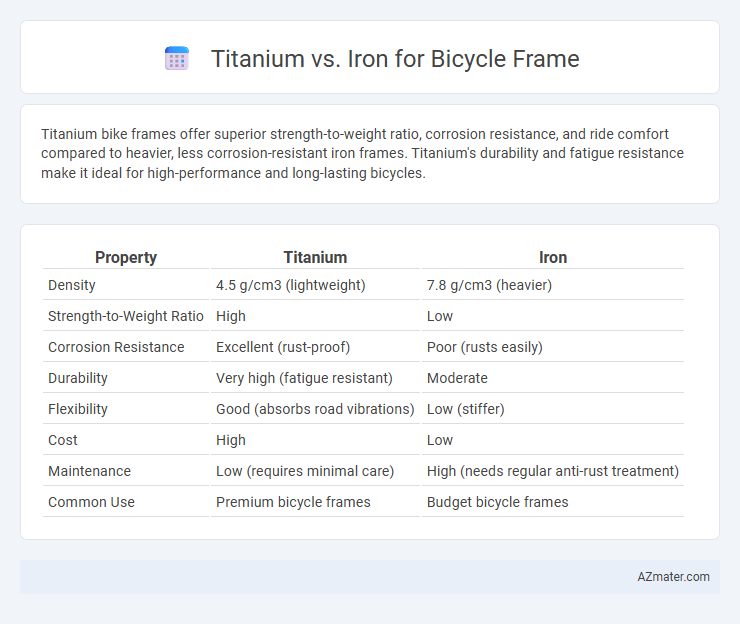Titanium bike frames offer superior strength-to-weight ratio, corrosion resistance, and ride comfort compared to heavier, less corrosion-resistant iron frames. Titanium's durability and fatigue resistance make it ideal for high-performance and long-lasting bicycles.
Table of Comparison
| Property | Titanium | Iron |
|---|---|---|
| Density | 4.5 g/cm3 (lightweight) | 7.8 g/cm3 (heavier) |
| Strength-to-Weight Ratio | High | Low |
| Corrosion Resistance | Excellent (rust-proof) | Poor (rusts easily) |
| Durability | Very high (fatigue resistant) | Moderate |
| Flexibility | Good (absorbs road vibrations) | Low (stiffer) |
| Cost | High | Low |
| Maintenance | Low (requires minimal care) | High (needs regular anti-rust treatment) |
| Common Use | Premium bicycle frames | Budget bicycle frames |
Introduction to Bicycle Frame Materials
Titanium offers a unique combination of lightweight strength and exceptional corrosion resistance, making it a premium material choice for bicycle frames compared to traditional iron or steel. Iron, primarily used in its steel alloy form, provides superior durability and cost-effectiveness but generally adds more weight, impacting overall bike performance. Advances in metallurgy have enhanced titanium's fatigue resistance and ride comfort, positioning it as a preferred option for high-performance and endurance cycling applications.
Overview of Titanium Frames
Titanium frames offer exceptional strength-to-weight ratio, making them lighter and more durable than traditional iron frames. They provide superior corrosion resistance, ensuring longevity and minimal maintenance in various weather conditions. The material's natural flexibility also enhances ride comfort by absorbing road vibrations better than iron.
Overview of Iron (Steel) Frames
Iron, commonly used in the form of steel alloys, offers high tensile strength and excellent durability for bicycle frames, making it a reliable choice for riders seeking long-lasting performance. Steel frames provide superior shock absorption and a comfortable ride quality due to their inherent flexibility compared to more rigid materials. Despite being heavier than titanium, modern steel alloys such as chromoly strike a balance between weight and strength, appealing to cyclists who prioritize toughness and affordability.
Weight Comparison: Titanium vs Iron
Titanium bicycle frames typically weigh between 1,000 to 1,200 grams, offering a lightweight design that significantly outperforms iron frames, which often exceed 2,500 grams due to iron's higher density. The lower weight of titanium contributes to increased bike agility and easier handling, enhancing overall ride efficiency and comfort. Titanium's superior strength-to-weight ratio provides durability without the added bulk found in iron frames, making it a preferred choice for performance cycling.
Strength and Durability Differences
Titanium bicycle frames offer superior strength-to-weight ratios compared to iron, providing high tensile strength without adding excessive weight. Titanium's excellent corrosion resistance significantly enhances frame durability, preventing rust and fatigue over time, whereas iron frames are prone to rust and require regular maintenance. The fatigue strength of titanium also surpasses iron, ensuring longer-lasting performance under repetitive stress and varied riding conditions.
Ride Quality and Comfort
Titanium bicycle frames deliver superior ride quality and comfort due to their excellent vibration damping properties and lightweight strength, reducing road buzz and rider fatigue. Iron frames, commonly steel, offer durability but tend to be heavier and transmit more vibrations, resulting in a harsher ride experience. Titanium's unique combination of flexibility and resilience makes it the preferred choice for long-distance cyclists seeking enhanced comfort.
Corrosion Resistance and Maintenance
Titanium bicycle frames offer superior corrosion resistance due to their natural oxide layer, which prevents rust and eliminates the need for protective coatings. Iron frames are prone to rusting and require regular maintenance such as repainting or anti-rust treatments to ensure longevity. Titanium's low-maintenance nature significantly reduces upkeep costs and effort compared to iron.
Cost and Affordability Factors
Titanium bicycle frames typically cost between $2,000 and $6,000 due to the material's high strength-to-weight ratio and corrosion resistance, making them premium options for serious cyclists. Iron frames, often found in budget-friendly or vintage bicycles, usually range from $150 to $500 but are heavier and more prone to rust, which can lead to higher long-term maintenance costs. For riders prioritizing affordability, iron frames offer initial savings, while titanium frames provide greater durability and performance value over time despite the higher upfront investment.
Customization and Aesthetic Appeal
Titanium bicycle frames offer superior customization options due to their excellent machinability, allowing for tailored tube shapes and personalized geometry that enhances rider comfort and performance. Their natural metallic luster and resistance to corrosion provide a sleek, timeless aesthetic that maintains its appearance with minimal maintenance. In contrast, iron frames, often heavier and prone to rust, limit customization potential and usually require coatings to achieve desired visual appeal, making titanium the preferred choice for cyclists prioritizing both bespoke design and lasting beauty.
Choosing the Right Frame Material for Your Needs
Titanium offers superior strength-to-weight ratio, corrosion resistance, and ride comfort, making it ideal for long-distance cycling and durability-focused riders. Iron frames, typically made from steel alloys, provide excellent stiffness and affordability but are heavier and more prone to rust, suited for budget-conscious cyclists prioritizing strength over weight. Selecting between titanium and iron depends on factors like riding style, budget, desired frame lifespan, and maintenance preferences to match performance with practical needs.

Infographic: Titanium vs Iron for Bicycle Frame
 azmater.com
azmater.com